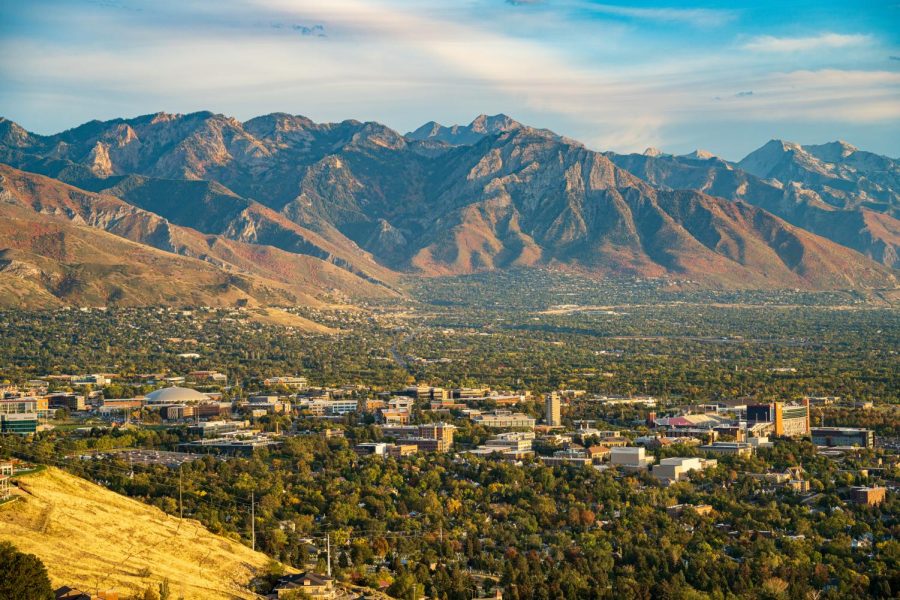U has Limited Involvement in Great ShakeOut as Nearly a Million Utahns Participate
The University of Utah campus in Salt Lake City, Utah on Oct. 5, 2021. (Photo by Xiangyao “Axe” Tang | The Daily Utah Chronicle)
April 21, 2023
The statewide Great ShakeOut earthquake drill took place on April 20, and nearly a million Utahns were registered to participate in the drill.
The University of Utah had limited involvement in the drill. The university has not fully participated in the Great ShakeOut in several years recently due to overlapping with the end of the academic year.
“Years ago, the U participated in the ShakeOut exercise in late April, but the feedback was the exercise wasn’t optimal for students, staff and faculty, who were at the end of an academic year and were holding final classes and preparing for exams,” said Stuart Moffat, interim director of emergency management at the U in an email interview.
Since then, Moffat explained the U has opted to hold its evacuation exercises in the summer semester to avoid disrupting finals, adding he believes it’s particularly important for Utahns and members of the U community to be prepared for an earthquake because they live in “earthquake country.”
Nearly 80% of Utah’s population lives along the Wasatch Front, which is one of the longest and most active normal faults in the world. Envision Utah wrote that the state is due for a big earthquake and the “Wasatch Fault has a forty-three percent chance of experiencing a 6.75 or greater magnitude earthquake in the next fifty years.”
“The same mountains in the valley that provide us beautiful vistas or great skiing, hiking, mountain biking and enjoying nature were formed by earthquakes, which occur regularly in Utah, albeit at much smaller magnitudes,” Moffat said. “Eventually, movement of tectonic plate forces in the earth can create larger magnitude earthquakes, causing significant shaking, potential landslides and liquefaction.”
Although most of the campus did not partake in the drill, Moffat encouraged students and faculty to “take advantage of the drill to check their individual or family plans, emergency food and water supplies, and emergency communications.”
Still, some areas of the U did participate in the ShakeOut, including the Natural History Museum of Utah, which completed a full evacuation.
“It’s a great opportunity for us to teach our staff and volunteers and visitors a little bit about earthquake safety, have an opportunity to give it a trial run, and see how it goes,” said Abby Curran, chief operating officer at the NHMU.
She added that the museum usually does four evacuation drills a year.
Curran feels it’s important to be prepared and teach people who didn’t grow up in Utah because they may not have the same knowledge as people who learned what to do in an earthquake growing up.
“More and more these days, you have people who are coming to Utah, for work, for school at the University of Utah, for so many different reasons,” Curran said. “And we need to have that knowledge in the event of an actual emergency.”
As someone who is herself from Maryland, Curran added she had no idea what to do when Salt Lake suffered a 5.7 magnitude earthquake in March of 2020.
“I felt the rumble and I jumped up out of bed and thought, ‘what do I do now?’” she said. “Whereas those who are from Utah are maybe a little bit more familiar, maybe had some training in elementary school.”
The NHMU partnered with emergency management for the drill, and at 10:15 a.m., all faculty, students and visitors evacuated the museum.
“I was able to coordinate with those university partners that were on site with us during the drill and report out the numbers of those who were safely evacuated, those who maybe needed additional assistance in the event of a real emergency,” Curran said.
In its entirety, the drill took about 20 minutes for the NHMU.
“I want to say that doing an evacuation drill is actually easier than you might think,” Curran said.
She added that she feels other areas of campus avoid participation in the Great ShakeOut because they feel like it’ll take too much time or throw off their end-of-semester schedules.
“It’s just 20 minutes,” she said. “And you know, for us, 20 minutes four times a year to help our staff and volunteers and visitors be comfortable and prepared in the event of an emergency is 20 minutes well spent.”








